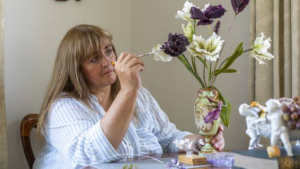15 Apr Tracy Byatt blooms after winning pattillo project

Tracy Byatt won with tulips made from sugar.
Tracy Byatt won the Open Award at this year’s pattillo Whanganui Arts Review securing her a cash prize and the pattillo project – a solo artist showcase exhibition at the Sarjeant Gallery to be held in 2021. Her winning work Parrot Tulips is made from sugar.
Why did you make Parrot Tulips – A Study in Sugar?
The Renaissance period has always held a deep fascination for me and is my favourite period in art history.
It was the time of ‘Tulip Mania’ and I have visions of the frenzied bulb trading that would have taken place in dark, smoky Dutch taverns during the 1600s.
Tulips were also a favourite of my grandmother, my great-grandmother so I guess I was always destined to recreate them and it was a joy to do so. The vase is also a family piece so it was particularly pleasing to be able to use it to display the flowers.
How did you go about making them so accurately?
Making botanical subjects from sugar is slow and intensive and involves a lot of studying, pausing, thinking, taking notes and sketching the tiniest of details from specimens as they grow in real-time. Much of my research is carried out under magnification to study those tiny parts of a plant that are hidden or overlooked. I always reproduce them in my work whether they are visible or not – it would feel like I was doing the plant an injustice if they weren’t included.
Do you photograph plants and flowers during the different stages?
I sometimes photograph plants as a backup, but find that a 2D image doesn’t translate well when trying to construct a 3D object, hence I always work from the real plant to obtain the best possible representation of form and colour. My preference is to sketch, this means that I can get a much better understanding of the plant as you’re truly seeing what’s in front of you and not just looking at it.
What materials do you use?
A very simple paste made of icing sugar, egg white and a glue which acts as a hardener.
What is it like to work with?
It’s excellent for making petals as it can be rolled wafer-thin – so fine you can read the newspaper through it. It’s very economical – a little goes a very long way.
How do you achieve the colours?
I use pastels which I grind to a dust and mix on a palette to colour match the flower. I apply it to the dried petals in thin layers with a brush and slowly build up the hue, much like a watercolour technique. The black tulip, for example, has up to six or seven layers of dust applied to each side of each petal.
What are the challenges in making this kind of art?
There are quite a few. The petals are extremely fragile once dry and can shatter at any given time. They are impossible to repair and so you have to start all over again.
It’s also a very unstable medium and becomes sticky in the heat, goes limp in humid conditions and crumbles at the mere sight of a rain cloud. Transporting is another challenge – if I can get down our lumpy, bumpy drive, I can usually make it to town in one piece although it’s always a white knuckle ride. An interesting dynamic occurred once the tulips were installed at Sarjeant on the Quay – in the controlled environment of the gallery, the flowers themselves started to curl and twist slightly as they dried out even further.
What are you doing during the lockdown?
Along with everyone else, we’re making sure our family stays safe and well and are keeping in contact with friends and neighbours. As with the whole farming community, we’re continuing to work as normally as we can during these unprecedented times. I also work full time from home and that continues.
What does winning the Open Award mean for you artistically?
As an amateur without any art qualifications I was completely overwhelmed to be the recipient of such a prestigious award. I’m a bit of a misfit in that I don’t belong to any particular category but just hover around the edges of different techniques without having really mastered any of them.
Entering the review has given me the purpose and drive to really push the boundaries of how I use my medium.
This article first appeared in the Whanganui Chronicle and NZ Herald online on 14 April. To view click here.

